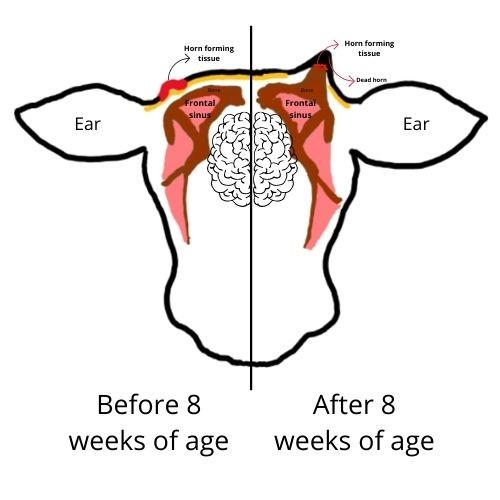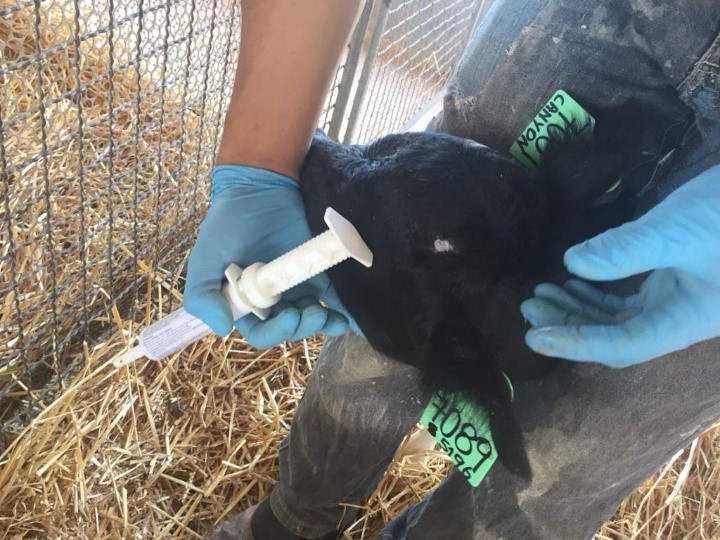Dairy farming essentials: Fine-tuning your calf disbudding management
Camila Lage, Dairy Management Specialist
Southwest New York Dairy, Livestock and Field Crops Program
Disbudding calves is no one's favorite task on the farm. However, like many things we often need to do, it is a necessary action to keep our cattle, and the people who work with them, safe. Horned cows are a potential source of serious injury to humans and other animals on farms as they use their horns against perceived threats or to assert dominance.
Since dehorning is a task we cannot avoid, the only reasonable solution is to make it easy and painless for both caretakers and calves. The standards in the FARM Program include developing a protocol with your herd veterinarian that demonstrates that pre-weaned calves are disbudded before 8 weeks of age and that pain mitigation practices are provided for disbudding. Dehorning performed after eight weeks is considered a surgical procedure and needs to be done by a licensed veterinarian. The best way to address any concerns is to talk with your vet about implementing a strategy that will work best for your operation
Before moving on to the practical aspects of disbudding calves, I would like to highlight why it is essential that we disbud animals before 8 weeks and use pain mitigation practices. According to the FARM CARE 4.0 manual, "the term disbudding refers to the destruction or excision of horn-producing cells before skull attachment. The time of attachment varies, but scientific literature indicates that this occurs around 8 weeks of age". Since there is no skull attachment yet, adopting an early disbud causes less injury and pain than removing attached horns (Figure 1).

Figure 1: Anatomy of horn formation before and after eight weeks of age
We can all imagine that both disbudding and dehorning are painful procedures. But we also have scientific evidence that this is the case (Stafford and Mellor, 2005). The administration of local anesthesia and NSAIDs has been shown to reduce pain, increase welfare, and reduce the impacts on the intake and performance of calves' post-procedure.
Which method to use?
Acceptable disbudding methods include applying a caustic paste or an electric/gas iron to the horn forming tissue. The best method for you will depend on factors related to your management and the preference of the caretaker. Regardless of the method of choice, the critical point is to ensure all the steps are being followed to assure your program's safety, welfare, and success.
If you are using a caustic paste
Things to keep in mind:
- Caustic paste is most effective if used within the first few days of life. This method is less effective and discouraged after the calf is two weeks of age.
- Applying paste on day one or two of life, limiting social interaction, and protecting treated calves from the rain aids in the success of using paste.
- The older calves get, the more prone they are to scratch their heads to rub the paste off. Some farms apply the paste after colostrum feeding when the calf is not moving around or during bottle feeding. Both strategies aim to distract the calves from the process, reducing their discomfort.
Procedure:
- Restrain the calf's head safely (use a halter or head restraint).
- Trim the hair on and around the horn bud before applying the paste.
- Proceed with nerve block anesthesia (talk to your vet about the best protocol for your farm).
- Apply petroleum jelly around the horn bud. The jelly will prevent the paste to spread to unintended areas.
- Don't use too much paste. Only a small amount (dime size) applied in a thin, even coating is needed for a young calf. Don't forget to wear gloves! (Extra tip: cover each pasted horn bud with duct tape or vet wrap to assure the paste stays where it needs!).
- Use Non-steroidal anti-inflammatory drugs (NSAID) as prescribed by the herd Vet in addition to local anesthesia to reduce the inflammation and associated pain following disbudding.

Figure 2: Only a small amount of paste (dime size) applied in a thin, even coating form is needed to disbud a small calf.
If you are using a hot iron:
Things to keep in mind:
- After the first week of age, the best method for disbudding is a hot-iron disbudding. The optimal window is between 7 days and six weeks of age.
- Restrain the calf's head safely (use a halter or head restraint).
- Trim the hair to expose each horn bud. Meanwhile, preheat the butane or electric calf dehorner.
- Use a device with a diameter just larger than the horn base to make sure to cauterize the skin immediately surrounding the horn bud.
- Proceed with nerve block anesthesia (Watch this video to learn more, and do not forget to talk to your vet about the best protocol for your farm).
- Make sure to inject both sides and wait ~10 minutes before using the iron so the anesthesia takes effect. To make sure the anesthetic is appropriately applied, gently touch the skin with the tip of a needle to see if the calf reacts. The anesthesia worked if the calf does not move its ears or head. If the calf is still feeling the needle, make sure to add an extra dose of anesthesia and waiting the appropriate amount of time for it to take effect before proceeding.
- Find the horn bud and proceed with positioning the hot iron. Apply minimal pressure and gently twist the hot iron around until a copper-colored ring forms (figure 3), approximately 10-20 seconds.
- Use non-steroidal anti-inflammatory drugs (NSAID) as prescribed by the herd vet in addition to local anesthesia to reduce the inflammation and associated pain following disbudding.
If you have questions about disbudding calves, please reach out to Camila Lage at cd546@cornell.edu or 607-422-6788
This information is for educational and reference purposes only and is not a substitute for sound veterinary consultation and following product labels. Cornell Cooperative Extension is dedicated to providing research-based information to our agricultural producers. Every effort has been made to provide correct, complete, and up-to-date recommendations. Producers are encouraged to work with their Veterinarian of Record (VOR), who is best able to develop the most appropriate, individualized pain management protocol for their operation. If you are an organic farmer, make sure to also consult a list of approved products for local anesthesia and pain management for dehorning/disbudding.
Other resources:
Understanding use of caustic paste to prevent horn growth on New York dairy farm
A step-by-step guide to disbudding calves using pain management - UC Davis
Dehorn calves with paste - Oregon State University
Dehorning: The least fun job on the farm - MSU Extension
Disbudding and Pain Management for FARM v4.0 - Vet Cornell
Disbudding Calves - UW Madison
Disbudding with Caustic Paste - Dairy Herd Management
Video - FARM Quick Convos - Pain Management for Disbudding [March 10, 2021]
Video: Dehorning: A Humane Practice Focused on Cow Safety - Drink-milk.com
Upcoming Events
WEBINAR - Automated Milking Systems Efficiency: Balancing Focus on Individual Cows and System Optimization
May 8, 2024
Please join Cornell the SWNY team and MSU Extension for our talk with Dr. Pablo Silva Boloña on improving efficiency of Automated milking systems by focusing on milking settings for individual and group success.
Broiler Field Day at Sunny Cove Farm
June 6, 2024
Alfred Station, NY
Join us for a field day to explore broiler production, processing, and finances. Meghan Snyder of Sunny Cove Farm will be our host. She raises small batches of organic broilers, processing them on-farm under the 1,000 bird exemption.
Cornell Seed Growers Field Day
July 2, 2024
Ithaca, NY
Please Save the Date for the Cornell Seed Growers Field Day to be held the morning of July 2nd. The event will be held at the NYSIP Foundation Seed Barn, 791 Dryden Rd., Rt. 366, Ithaca, NY.
Announcements
No announcements at this time.





